
|

|
|
Home Site Search Contact Us Subscribe
|
|
|
One-on-One: Architecture as a Social Instrument: Interview with Bjarke Ingels of BIG It is not for nothing that this young architect is referred to as the "Yes Man" with a willingness - and ability - to please just about everyone. By Vladimir Belogolovsky March 1, 2011 Editor’s note: This interview was published in the Winter 2010 issue of Tatlin magazine, reprinted here with permission.
Bjarke Ingels is an upcoming star of contemporary architecture. His energy and eloquence with which he presents his work could make any politician envious. Actually, architecture for Ingels is somewhat like politics, and his creative practice represents a tempting political program. Ingels’ projects are extraordinarily interesting and original. But what distinguishes them from other architects’ novelties is his ability to find the balanced compromise between the original form and the functional content that would satisfy literally everyone – developers, investors, politicians, engineers, contractors, builders, and the public.
It is not for nothing that this young architect is referred to as the “Yes Man,” the person who says “yes”; his motto is “Yes is more” – more mutual understanding, more concessions, more approvals, and therefore more commissions. The architect admits openly that he doesn’t waste his time on basing his visions on the latest fashionable form-generating theories. First and foremost his forms respond to specific site and program conditions. And they take into account the preferences of all concerned parties. Ingels insists that this is what makes his approach radical: his willingness to please everyone turns the process of the architecture-making into a certain alchemy, which allows the architect to create his sophisticated new forms.
“As architects,” says Ingels, “our role is often reduced to the beautification of predetermined programs. Architects only get involved when the decision to build has been made, when the site has been found, and when the size and content of the program have been decided. Thus architects and architecture rarely have any decisive influence on how the physical structures of society evolve. The role of architecture is often reduced to cosmetics. As architects constantly working in and with the city, you would think that we would be at the frontier of envisioning our urban future. However while we sit at home waiting for the phone to ring or someone to announce a competition, the future is being decided by those with power: the politicians, or those with money: the developers.”
Ingels initiated several projects on his own. The truth is that when his office would come up with projects that no one has asked for there was a greater chance of realization than in the architect’s attempt to win a prestigious international competition. This way it is possible to be the first at formulating a problem and finding the appropriate solution before anyone else. It is acknowledged that there can’t be good architecture without a good client, but in that case why shouldn’t the architect himself choose the right commission and find the client who would be willing to realize it?
Bjarke Ingels was born in Copenhagen in 1974, where he graduated from the Royal Academy of Arts in 1999 and also studied at the School of Architecture of Barcelona. For three years Ingels worked at Rem Koolhaas’s Office for Metropolitan Architecture/OMA in Rotterdam (1999-2001), and then co-founded PLOT Architects with his partnerJulien De Smedt. In 2005 he started the Bjarke Ingels Group (BIG). Despite its young age, the company now employs more than 60 architects. BIG often wins international competitions, such as the Danish Pavilion at the World Expo 2010 Shanghai; the National Library in Astana, Kazakhstan; Tallinn Town Hall, Estonia; Faroe Islands Education Center in Denmark; and the mountain range-like residential complex Zira Island Master Plan in Baku, Azerbaijan.
Ingels’ projects have won numerous awards. The Stavanger Concert Hall in Norway was awarded the Golden Lion at 2004 Venice Architecture Biennale and his two residential complexes, VM Houses and Mountain Dwellings in Copenhagen, won the Forum AID Award for the best building in Scandinavia in 2006 and 2008 respectively. In 2008 the Mountain Dwellings project was also named the best residential complex at the World Architecture Festival in Barcelona, and in 2009 the same project won the ULI Award for Excellence given by the Urban Land Institute.
The architect has given numerous lectures around the world. He has taught at the Royal Academy of Arts in Copenhagen, Rice University, and presently has been teaching at Columbia University and Harvard.
In 2009 the Danish Architecture Center in Copenhagen presented BIG’s large solo exhibition under already familiar title “Yes is More.” The exhibition’s catalogue became the first monograph of Ingels’ projects.
Our conversation took place in a busy restaurant in Manhattan in between his design critique at Columbia University and a public lecture at Cooper Union.
Vladimir Belogolovsky: Architecture wasn’t something you aspired to do as a child, right? I read that as a teenager you wanted to become a graphic novelist and that you grew a passion for architecture after becoming a student at the Royal Art Academy in Copenhagen.
Bjarke Ingels: I went to architecture school at the Academy basically to get better at drawing. But after two years of free-hand drawing and other technical classes, I was exposed to architecture and got intrigued by it. Apart from Lego or cool buildings in James Bond movies, architecture was an art form that I never had any interest in. The tipping point for me was when I discovered that architecture is not just an art form, but you can’t think about it independently of social, economic, and political issues. Political science was my major in high school so I embraced the idea that architecture is relevant to real life issues. My professors at the Academy spoke less about aesthetics and more about architecture’s impact on people. There was a lot of excitement about what is possible.
VB: You started your own practice before graduation. What was that experience like?
BI: In 1998, when I was still a student, I partnered with four other students in Barcelona to work on a two-stage competition for a university campus expansion. We were selected as finalists along with nine other firms and were given $90,000 to develop our scheme. We took a break from school and rented an office to complete the project. We knew each other for just a couple of weeks before the competition and we didn’t really share a common vision. In the end we submitted a kind of Frankenstein and did not get any award – but it was a good experience.
VB: And the end of your collaboration?
BI: Yes, it was the end of my first collaboration.
VB: Apart from the fact that Barcelona is one of the most beautiful cities in the world, why did you go there for your studies?
BI: I wanted to live in Barcelona, but the main reason was to study with Enric Miralles (1955-2000). At that time I was interested in questions of tectonics and I was really inspired by such architects as Aalto, Miralles, and Siza. But after taking the Miralles course I became very disappointed with his teaching and dropped out. To me it didn’t make any sense. There were incomprehensible collages of everything mixed together: French philosophy, historical references, ideas of movement in space, medieval street grids, patterns found in nature, poetry, and so on. I couldn’t understand how all of that related to real life. I was inside a bubble that was completely disassociated with the rest of the world. I would go out of the studio and see traffic, people, bicycles, shopping malls. I would go back to the studio and none of that would matter. It wasn’t my world.
VB: So you are not interested in French philosophy.
BI: I am, but not in a literal sense – the way architects read it. They read Deleuze’s The Fold: Leibniz and the Baroque and they literally start to use the folds. To me philosophy is not the goal. Life is the goal. Philosophy is a creative act that helps to expend possibilities of life.
VB: So you went back to Copenhagen?
BI: After Barcelona I went back to Copenhagen to graduate from the Academy and then went to work at OMA for Rem Koolhaas where I worked on the Seattle Library project.
VB: Why were you interested in Rem Koolhaas?
BI: Education at the Academy was very liberal and I spent a lot of time in the library and through books I discovered Rem Koolhaas. He triggered my interest. Through his books I discovered Corbusier and the idea that architecture can be an instrument of society rather than an autonomous art form.
VB: You discovered Koolhaas before Le Corbusier?
BI: So it happened.
VB: You worked for Koolhaas for three years. What did you learn from him?
BI: Rem Koolhaas was a major discovery for me and that’s why I wanted to work for him. I can’t think of contemporary architecture without him. He is the major force in my education. He taught me not so much about how to design a beautiful building as an isolated object, but how to use architecture as a tool for engaging in development, politics, social structures, and to be free to realize various means of expression. Architecture for him is not about aesthetics. Architecture is not driven by styles, but by ideas.
Our architecture is never triggered by a single event, never conceived by a single mind, and never shaped by a single hand. Neither is it the direct materialization of a personal agenda or pure ideals, but rather the result of an ongoing adaptation to the multiple conflicting forces flowing through society. We architects don’t control the city – we can only aspire to intervene. Architecture evolves from the collision of political, economical, functional, logistical, cultural, structural, environmental, and social interests, as well as interests yet unnamed and unforeseen.
VB: Among your inspirations you named science fiction writer Ian M. Banks. How does his work influence your architecture?
BI: He is a good thinker and he is a great speculator on future possibilities. Many of his speculations have to do with architecture and creations of new worlds which is about the relationship between the technology and social life. I also like to read Wired magazine because it surveys the impact of technological innovations on social, political, and cultural life.
---------------------------------------------------------
Reflecting on Ingels’ words, I have felt that he is convinced that by means of architecture it is possible to solve the most diverse issues of the society. There is a certain exaggeration for such certainty. I recollect Peter Eisenman (by the way, a teacher of Rem Koolhaas), who asserts exactly the opposite: “Architecture does not solve questions. On the contrary it generates new ones. It does not solve problems, rather it creates new ones.”
To me the notion of architecture as art is more suiting. In any case, the fact that the young architects learn about Koolhaas before they discover Corbusier, and, probably, such masters as Gaudí or Wright, should be a signal that something is wrong and even dangerous breeding in our schools.
In architecture the presence of an inspiring, beautiful idea is important and one should not seek it in the preferences of the investors and contractors. There are many sources to turn to – whether it is nature, the cosmos, or anything that would not equate the process of architecture-making to alchemy. As far as aiming at solving ordinary pragmatic problems, by and large, it is not at all necessary for society to turn to architects. But it is the architects who need to define their position in principle – should they be led by others or should they be the leaders.
Vladimir Belogolovsky, founder of the New York City-based Intercontinental Curatorial Project Inc., organizes, curates, and designs architectural exhibitions worldwide. Trained as an architect at Cooper Union, he has published more than 100 articles in American, European, and Russian publications, and is the American correspondent for the Russian architectural journals Architecturny Vestnik, SPEECH, and TATLIN. He has authored several books, including Felix Novikov for the series Masters of Soviet Architecture, and GreenHouse on leading sustainable projects. His book Soviet Modernism: 1955-1985, written with architect Felix Novikov, was released in October 2010. He can be reached at vbelogolovsky@gmail.com.
Also by Vladimir Belogolovsky
Putting Colors
Together: An Interview with Will Alsop
The Art of Ennobling Communities: Interview with Sara
Caples and Everardo Jefferson
One on One: Elusive
Architecture: Interview with Kengo Kuma |
(click on pictures to enlarge)  © BIG Scala Tower, Copenhagen, Denmark: retail, a conference center, the new Main Library of Copenhagen, offices, a luxury hotel, and a public rooftop plaza  © BIG Scala Tower 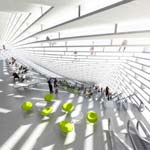 © BIG Scala Tower  © BIG Tallinn City Hall, Estonia 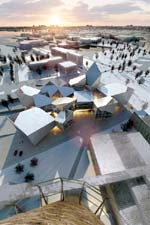 © BIG Tallinn City Hall, Estonia  © BIG ZIRA Island: aerial view of the Seven Peaks of Azerbaijan  © BIG ZIRA Island: view over Zira’s interior 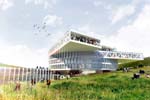 © BIG/Fuglark Faroe Island Education Center, Denmark, by Bjarke Ingels Group/BIG and Fuglark  © BIG Danish Pavilion at the World Expo 2010 Shanghai 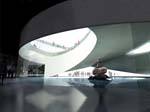 © BIG Danish Pavilion at the World Expo 2010 Shanghai 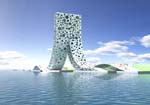 © BIG REN: People’s Building, Shanghai, a proposed hotel and sports/conference center for World Expo 2010  © Matteo Sartori MTN: Mountain Dwellings, Copenhagen, Denmark (2008), by Bjarke Ingels Group/BIG with JDS/Julien De Smedt Architects 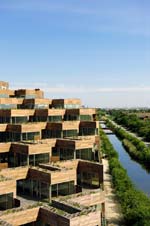 © Jakob Boserup MTN: Mountain Dwellings 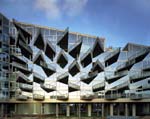 © Johan Fowelin VM Housing, Copenhagen, Denmark, by BIG with PLOT and JDS/Julien De Smedt Architects |
© 2011 ArchNewsNow.com